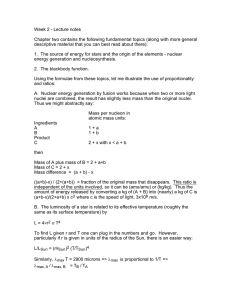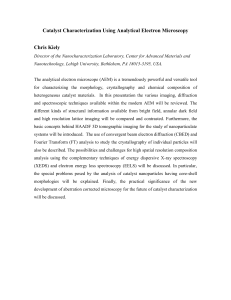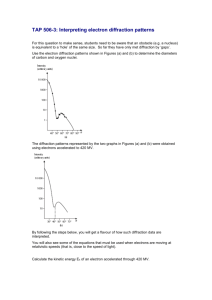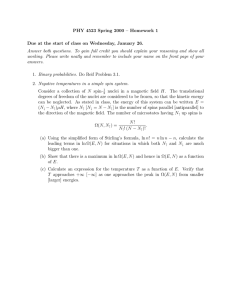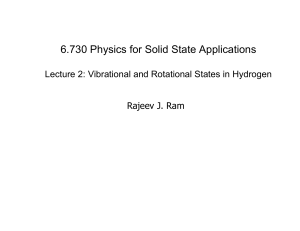Document 13488538
advertisement
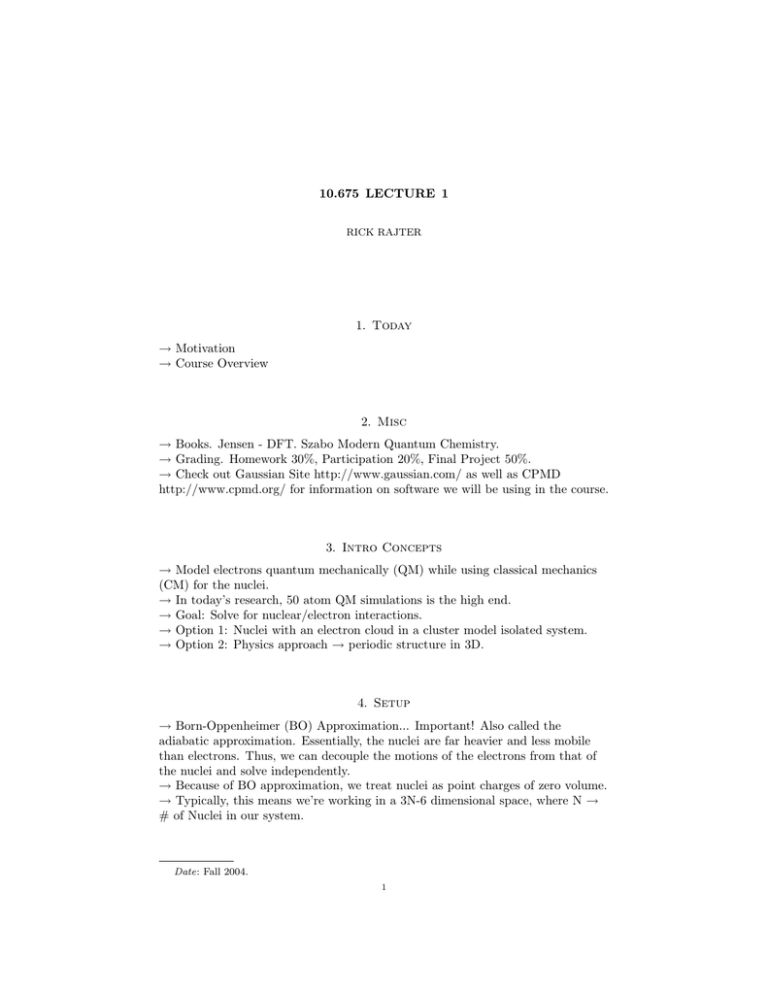
10.675 LECTURE 1 RICK RAJTER 1. Today → Motivation → Course Overview 2. Misc → Books. Jensen ­ DFT. Szabo Modern Quantum Chemistry. → Grading. Homework 30%, Participation 20%, Final Project 50%. → Check out Gaussian Site http://www.gaussian.com/ as well as CPMD http://www.cpmd.org/ for information on software we will be using in the course. 3. Intro Concepts → Model electrons quantum mechanically (QM) while using classical mechanics (CM) for the nuclei. → In today’s research, 50 atom QM simulations is the high end. → Goal: Solve for nuclear/electron interactions. → Option 1: Nuclei with an electron cloud in a cluster model isolated system. → Option 2: Physics approach → periodic structure in 3D. 4. Setup → Born­Oppenheimer (BO) Approximation... Important! Also called the adiabatic approximation. Essentially, the nuclei are far heavier and less mobile than electrons. Thus, we can decouple the motions of the electrons from that of the nuclei and solve independently. → Because of BO approximation, we treat nuclei as point charges of zero volume. → Typically, this means we’re working in a 3N­6 dimensional space, where N → # of Nuclei in our system. Date: Fall 2004. 1 2 RICK RAJTER → We are trying to determine the potential energy surfaces. 5. Notation Introducing the time­independent Schrödinger Equation (SE). HΨi = Ei Ψi Where H is the Hamiltonian for the system, and Ei ’s are the Eigenvalues. 6. Hydrogen The Hamiltonian is as follows. −�2 � 2 e2 � Ψi − Ψi = Ei Ψi 2me r q2 4π�0 From now on, and for the rest of these lectures, we will be using atomic units to stop us from writing out all the miscellaneous constants each and every time. 2 ˚ → length bohr ao = � 2 = 0.52918A e2 = me → energy hartree Eh = e2 = 27.21eV → 1 eV = 23.06 Kcal/mol The SE thus becomes 1 −1 � 2 � Ψi − Ψi = Ei Ψi 2 r 7. Many Body Schrödinger Equation ­ No spin H= N N M N � N � −1 � � 2 � � Zk Zk �i − + � 2 i=1 r�i − Rk i=1 j<i r�i − R�j i=1 k=1 First term is electron KE, second term elec/nuc interaction, last term is elec/elec interactions. Nuc/Nuc terms are ignored for the time being. N → Electrons M → Nuclei The electron/electron interaction term is the hardest part as ri and rj are not separable. 10.675 LECTURE 1 8. Solving Many different ways of going about it Single particle equations, solve through self consistent field (SCF) ”Mean Field Theory”. Molecular orbital theory. → Hartree­Fock Methods. Density Functional Theory (DFT). In all approaches, there are no adjustable parameters. 9. Demos/Examples Gaussian Code Intro ­ Gaussview Display Catalyst Design, paper → Steam Reforming Catalyst. Science, 20 March, 1998, Vol 279, 1913. CH4 + H2 O + N i → CO + 3H2 + N i →Problem: Ni catalyst ”cokes”, ie carbon deposits on the surface. A) 2CO ↔ C(S) + CO2 B) CH4 ↔ C(S) + H2 Coking Deactivates the process. GOAL: Investigate the coking reactions with/without Au. Want to hinder nucleation of C(s) . Objective: Have the catalyst slective for reaction A over B. Choose the model surface (Ni 111 plane) Investigate surface reaction CH4 → CH3 + H rate limiting step. Add gold, how will it effect this rxn? Compare with Experiment... which it all worked with almost NO coking. 3

